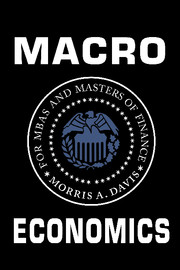5 - Business Cycles
Published online by Cambridge University Press: 05 June 2012
Summary
Objectives of this Chapter
We start the chapter by listing the dates of the business cycles experienced in the US after World War II as defined by a group of economists at the National Bureau of Economic Research (NBER).
We then review how economists define and measure cycles. We start with a discussion about how any series can be split into a trend and a cycle, and show that, by definition, different estimates of trend yield different estimates of cycles. We compare two different methods for detrending real GDP: a straight-line method and a more general method called the HP-Filter which encompasses the straight-line method. We discuss the derivation of the HP-Filter and how it is implemented and used in practice.
Next, we define four important properties of cyclical macroeconomic data: that is, properties of key macroeconomic data after the HP-Filter has been applied: (1) consumption is less volatile than GDP, (2) investment is more volatile than GDP, (3) hours worked is as volatile as GDP, and (4) hours worked, consumption, and investment are “pro-cyclical,” meaning that when GDP is above trend, these other variables tend to be above trend as well.
At the end of the chapter, we briefly review the modern theory of business cycles, which suggests that business cycles arise when optimizing firms and households respond to fluctuations in the level of technology. Since the level of technology is, on average, increasing over time, the modern theory of business cycles is fundamentally linked to the theory of growth.
- Type
- Chapter
- Information
- Macroeconomics for MBAs and Masters of Finance , pp. 167 - 190Publisher: Cambridge University PressPrint publication year: 2009



